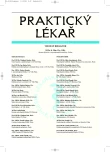Chronic damage of the triangular fibrocartilage complex
Authors:
J. Pilný 1; A. Švarc 1; P. Hoza 1; L. Pliska 2; I. Dospěl 3
Authors‘ workplace:
Ortopedické oddělení, Krajská nemocnice Pardubice
Primář: MUDr. Jiří Kubeš.
Fakulta medicínských studií, Universita Pardubice
Děkan: prof. MUDr. Arnošt Pelant, DrSc.
1; Traumatologické oddělení, FN Ostrava
Primář: doc. MUDr. Leopold Pleva, CSc.
2; Traumatologické oddělení, FN Olomouc
Primář: MUDr. Igor Čižmář, Ph. D.
3
Published in:
Prakt. Lék. 2008; 88(8): 454-456
Category:
Of different specialties
Overview
The authors review one cause of chronic pain of the ulnar side of the wrist - damage to the triangular fibrocartilage complex (TFCC). In 2006 and 2007 they carried out 148 wrist arthroscopy operations. Chronic damage of TFCC was found in 78 wrists of 74 patients, 4 patients were operated on both wrists. 52 of them were females and 22 were males with an average age of 44.6 years. The dominant hand was operated on in 48 patients. Damage was evaluated by Palmer’s classification as follows: type II.A 17 cases, type II.B 22, type II.C 16, type II.D 19 and type II.E 4 cases. Arthroscopic resection of TFCC by special electrocoagulation was processed during arthroscopy in patients with pre-operative symptoms TFCC damage. Arthroscopic resection of the head of the ulna was performed in 6 patients aged over 50 with chondromalacia on the head of the ulna. 4 patients younger than 50 with diagnosed chondromalacia and persistent pain on the ulnar side of the wrist after operation were treated by ulnar-shortening osteotomy in the 2nd-step of the treatment. 12 patients with diagnosed rupture of the lunotriquetral joint and persisting pain were treated by reconstruction of the lunotriquetral ligament in the second-phase of treatment.
Key words:
Triangular fibrocartilage complex, arthroscopy of the wrist, wrist.
Sources
1. Corso, S. J., Savoie, F.H, Geissler, W. B. et al. Arthroscopic repair of peripheral avulsions of the triangular fibrocartilage complex of the wrist: a multicenter study. Arthroscopy, 1997, 13, 2, p. 78-84.
2. Čižmář, I., Jindra, M., Sedlák, P. a kol. Artroskopie zápěstí. Čas. lék. čes., 2007, 146, s. 156-159.
3. Dráč, P., Maňák, P. Současné možnosti diagnostiky zlomenin člunkové kosti – přehled literárních poznatků. Úraz. chir., 1999, 7, s. 1-5.
4. Geissller, W.B., Freeland, A.E., Savoie, F.H. et al. Intracarpal soft-tissue lesion associated with an intra-articular fracture of the distal end of the radius. J. Bone Joint Surg. Am., 1996, 78, 3, p. 357-365.
5. Hart, R., Janeček, M., Višňa, P., Čižmář, I. Poúrazová periskafoidní artróza a možnosti jejího řešení. Slov. chirurg., 2002, 3, s. 19-23.
6. Oneson, S.R., Timins, M.E., Scales, L.M. et al. MR imaging diagnosis of triangular fibrocartilage pathology with arthroscopic correlation. Am. J. Roentgenol. 1997, 168, p. 1513-1518.
7. Osterman, A L. Arthroscopic debridement of triangular fibrocartilage complex tears. Arthroscopy 1990, 6, p. 120-124.
8. Palmer, A.K. Triangular fibrocartilage complex lesions: a classification. J. Hand Surg. 1989, 14, 4, p. 594-606.
9. Pederzini, L., Luchetti, R., Soragni, O. Evaluation of the triangular fibrocartilage complex tear by arthroscopy, arthrography, and magnetic resonance imaging. Arthroscopy 1992, 8, 2, p. 191-197.
10. Pilný, J., Čižmář, I. a kol. Chirurgie zápěstí. Praha: Galén, 2006. s. 16.
11. Shahane, S. A., Trail, I. A., Tkwale, V. J. et al. Tenodesis of the extensor carpi ulnaris for chronic, post-traumatic lunotriquetral instability. J. Bone Joint Surg Br. 2005, 87B, p. 1512-1515.
Labels
General practitioner for children and adolescents General practitioner for adultsArticle was published in
General Practitioner

2008 Issue 8
Most read in this issue
- Chronic damage of the triangular fibrocartilage complex
- Acute facial palsy – a comparison of clinical and laboratory parameters in patients with Borrelia and idiopathic aetiology
- Stenosis of the left subclavian artery as a cause of angina pectoris progression after CABG: coronary-subclavian steal syndrome
- Acute exacerbation of chronic obstructive pulmonary disease as seen by the intensivist
